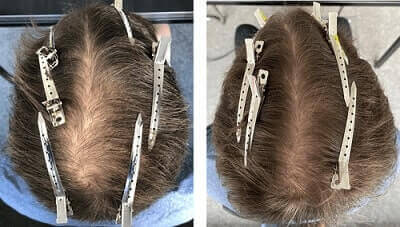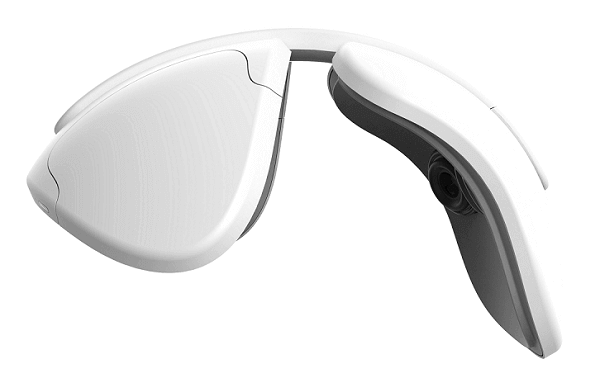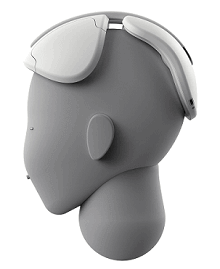For the past couple of years, various readers have inquired about Mane Biotech (now niostem) and its hair loss App and device. The company CEO Dr. Carlos Chacón shared several updates with me in 2021, but told me that they were still in stealth mode. This is no longer true, and he e-mailed me some interesting new details a couple of days ago.
Update: May 1, 2023
FYI — Per Emil, Indiegogo started including a “tip” option at check-out. If you select “other” and “0”, you can avoid over-paying.
Niostem Indiegogo Campaign
Niostem sent me an update. They now have a fixed date for their official Indiegogo campaign launch: May 2nd, 2023 at 3:00pm Berlin time. Follow their Instagram page for updates.
- Live on IGG on May 2nd. Make sure to sign up for Indiegogo (IGG) first.
- They will be offering a money-back guarantee if the device does not produce results (details will be elaborated on IGG).
- Backers of the campaign (buyers) will have the possibility to apply for the chance to participate in a larger German clinical study. Assuming they fulfill the inclusion criteria and buy the device in IGG.
- The number of devices for sale will be limited.
- The Niostem team was chosen amongst the “The Top12 Wearable Techpreneurs 2023” in the Wearable Technologies Conference Europe 2023. Six hundred entities submitted their solution for consideration.
February 6, 2023
Pilot Study Results and Clinical Trial in 2023
After I wrote this post, Dr. Chacón sent me a before and after photo and detailed update. I summarized the main points below.

- They call their hair follicle reawakening process “Stem Cell Reactivation Technology“.
- In the initial pilot study, after 3 months of continued device usage, hair loss stopped completely in 95.4% of patients, and most of those also showed some hair regrowth. Moreover, after 6 months of use, 100% of participants saw a cessation in hair loss. And they showed an average hair growth of 19.3% and an average hair thickness increase of 9% .
- There were minimal adverse side effects: itchy scalp (scalp pruritus) in 9% of patients and a slight headache in 4.5% of patients. All during the first 2-4 days of use.
- Niostem plans to initiate a much larger clinical trial in Germany in the middle of 2023. Recruitment starts soon and they will likely include some potential customers.
- The internal pilot was a 6-month clinical validation study consisting of 22 men between 21 and 40 years of age. All had male pattern baldness (Norwood scale 2-6). The quantitative hair density analysis was independently performed in a blind manner by Surry Trichology Clinic, UK through trichoscopy imaging.
- Their results were 6x more effective in hair regrowth and 2x faster than the top FDA-approved anti-hair loss drug, Finasteride. The mean hair density increase with Niostem at 6 months was 42 hairs/cm2. In comparison, it was a 7.2 hairs/cm2 increase after 12 months of Finasteride 1 mg per day use (based on Neste et al, 2000). Not sure why they picked this particular study for comparison.
- With Monasterium Lab, they ran some ex vivo experiments (proof-of-principle/concept) with follicular units. Niostem collaborated with them as a CRO.

Niostem: New Name for Mane Biotech
Of most importance, Mane Biotech has been rebranded to niostem. On the new company’s website, it says that they are headquartered in Germany and the hair loss device will be launched in 2023. Note that niostem’s co-founders are Dr. Chacón and a person named Emil Aliev.
The before and after photos on niostem’s website show significant hair growth after 6 months of device use. One of the reasons that this product is coming out so fast is because no clinical trials seem to have been required. I am pleased about this, because most companies that undergo three phases of clinical trials take forever (e.g., Follica) or often give up due to lack of funding.
Note there there is one online anecdotal report on the German hair loss forum from someone who took part in a Mane Biotech study. Not sure if reliable.
Dr. Chacón previously worked at the prestigious Max Planck Institute for Biology for Ageing in Germany. Some of his past research on hair follicle stem cells can be found here and on his Linkedin.
He is one of the co-applicants in a patent filed by the Max Planck Institute in 2016. It entails the culturing of epidermis-derived stem cells, including hair follicles. Among the papers co-authored by Dr. Carlos Chacón-Martínez include a 2021 one on hair follicle stem cell fate.
Electrical Stimulation of the Scalp
Interestingly, one of his patents relates to an electric device to stimulate hair growth. It was filed in 2020 by Mane Biotech and is still pending. I suspect that niostem’s new low-level electrical stimulation hair growth device makes use of the discoveries in the above patent.
Although this concept might sound like fantasy, I actually wrote an entire post on electricity and hair growth in the past. There is some evidence that electric stimulation can reactivate the dormant stem cells surrounding miniaturized hair follicles. Thereby leading to hair regeneration.
On a related note, hair growth lasers also work via a similar concept, but involve light energy instead of electricity. And recently, I also discussed sound energy and hair growth.
Niostem Device Releasing in 2023

According to the podcast embedded at the bottom of this post, the wearable device is lightweight and wireless. It needs to be used a few days a week for life if you want to hold on to any gains. On niostem’s website FAQ section, it says the product will release in 2023.
Among the advantages of this device versus most existing hair loss treatment options include:
- No side effects that can happen with medications.
- Ease of use. You can wear it like a cap or helmet while doing chores. But do not use it outdoors in case of rain or snow.
- No messy application process such as with topical hair loss products or hair thinning shampoos.
Niostem’s Twitter and Instagram pages can be followed for the latest updates.
Last month, Dr. Chacon gave an interview on the “Products with Purpose” podcast that is worth a listen. The company has been working on this wearable device for almost four years. He mentions that they verified their results at the well known third party Monasterium Laboratory. The hair growth increase after 6 months of device use was 19%.
They plan to launch an Indiegogo crowdfunding round in March. This technology has further implications to overall stem cell rejuvenation and human health and longevity.